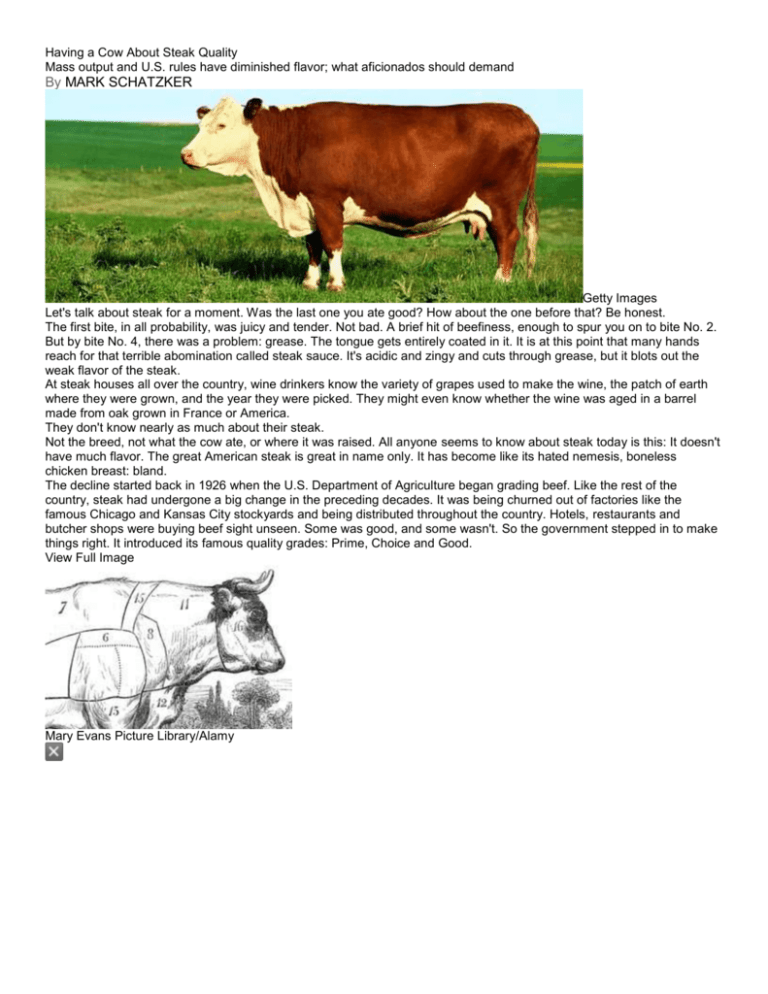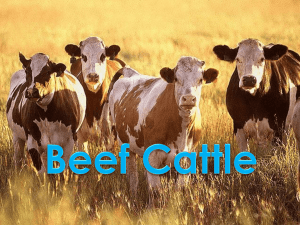
Having a Cow About Steak Quality
Mass output and U.S. rules have diminished flavor; what aficionados should demand
By MARK SCHATZKER
Getty Images
Let's talk about steak for a moment. Was the last one you ate good? How about the one before that? Be honest.
The first bite, in all probability, was juicy and tender. Not bad. A brief hit of beefiness, enough to spur you on to bite No. 2.
But by bite No. 4, there was a problem: grease. The tongue gets entirely coated in it. It is at this point that many hands
reach for that terrible abomination called steak sauce. It's acidic and zingy and cuts through grease, but it blots out the
weak flavor of the steak.
At steak houses all over the country, wine drinkers know the variety of grapes used to make the wine, the patch of earth
where they were grown, and the year they were picked. They might even know whether the wine was aged in a barrel
made from oak grown in France or America.
They don't know nearly as much about their steak.
Not the breed, not what the cow ate, or where it was raised. All anyone seems to know about steak today is this: It doesn't
have much flavor. The great American steak is great in name only. It has become like its hated nemesis, boneless
chicken breast: bland.
The decline started back in 1926 when the U.S. Department of Agriculture began grading beef. Like the rest of the
country, steak had undergone a big change in the preceding decades. It was being churned out of factories like the
famous Chicago and Kansas City stockyards and being distributed throughout the country. Hotels, restaurants and
butcher shops were buying beef sight unseen. Some was good, and some wasn't. So the government stepped in to make
things right. It introduced its famous quality grades: Prime, Choice and Good.
View Full Image
Mary Evans Picture Library/Alamy
How did the USDA separate the good beef from the bad? There was one thing everyone from ranchers and cowboys to
butchers and USDA graders could agree on: fatter cattle tasted better than lean ones, so long as they weren't too old. So
that's what they looked for: plump, well-fed cattle. They looked for fat on the ribs called feathering, and fat on the flank
called frosting. If there was a great deal of that fat, the beef achieved the highest grade, Prime.
In the 1960s, graders began cutting a side of beef and looking for the dots and swirls of fat within the exposed rib eye.
This fat is called marbling. The more marbling in a rib eye, the higher the grade. Other than that, not much has changed at
the USDA. What a beef grader prized in 1926 is the same thing a grader prizes today: fat.
It's the cattle industry that has changed. In the 1950s, cattlemen began sending their cattle to feedlots to get fat. A feedlot
is a vast sprawl of fenced-in pens where tens of thousands of cattle eat grain—usually corn—out of concrete troughs.
Soon after, cattlemen started using growth promotants—hormones and steroids, basically—to get cattle fat faster, and fed
them antibiotics so they could eat corn in amounts that, under normal conditions, could kill them.
By the turn of the century, a new drug entered the scene: the beta2-adrenergic agonist, a muscle relaxant used in humans
to treat heart and respiratory disease that makes cattle gain more muscle. And the corn cattle now eat, not surprisingly,
has also taken great strides in efficiency, having been hybridized and genetically engineered to pack more fat-producing
starch. More recently, we've been feeding cattle something called dried distillers grains, which is the muck that's left over
after corn is distilled into ethanol.
The result has been astonishing. In the 1950s, a cow was about two years old by the time it got fat. Today, it can be as
young as one year old. An average carcass now yields 40% more beef than it did just 30 years ago. In short, the beef
industry has experienced a tectonic supply-side shift. Production has become vastly more efficient. In 2009, beef cost
30% less than in 1974. Yet the average American is eating 20 pounds less of it per year.
The USDA is not alone in worshipping at fat's altar. "Fat is flavor" is the mantra of the grilling world. Unfortunately, it's not
true.
Fat imparts mouth feel and richness in food. Fat can make a steak juicy and goad the mouth into salivating. But fat doesn't
carry much in the way of taste. Consider wild venison or moose. The meat possesses virtually no marbling, and yet it's
very flavorful—some would say too flavorful.
It helps to understand what the cattle industry looked like in 1926. Then, feedlots were still decades away. The vast
majority of beef cattle were fattened on grass—according to the USDA, in 1935 a mere 5% of cattle were fattened on
grain, and not much grain by today's standards.
Cattlemen were not paid to make cattle delicious. They were paid by the pound. And since marbled beef commanded a
better price per pound, the beef business got very good at producing marbled beef more efficiently.
Today, four big companies—Cargill, JBS Swift, National and Tyson Foods—dominate beef packing. Feedlots and
slaughterhouses have gotten enormous. At every level, the chain of beef production has been tweaked to get cattle fat
cheaply. But mass production is not without its drawbacks. Cheap beef doesn't taste good. What we have gained in yield
and efficiency, we've lost in flavor.
The change has been gradual, so much so that most people haven't noticed the steady decline in strip loins or rib eyes.
But we don't love steak the way we used to. It isn't the prestige food it once was. That honor is now held by whey-fed
pork, foie gras or rare sashimi flown in from Japan. When we go out for steak, we spend more time talking about the wine.
So, what makes a steak flavorful?
At last count, 340 flavor compounds. (Which, incidentally, is a mere 46 fewer flavor compounds than have been found in
red wine.) These are the complex chemicals that are produced when a steak is subject to the intense heat of a pan or grill.
They are formed by everything you find in a steak—amino acids, water, sugars, fat, you name it.
Science, however, hasn't come anywhere close to solving the mystery of great steak. It has yet to determine precisely
which compounds in steak are desirable, and how they can be achieved. But that probably has more to do with the fact
that there's more research funding in getting cattle get fat quickly than there is in making them taste delicious.
Extraordinary steak does exist, however. The way a steak tastes has a lot to do with what a cow eats—and the best beef
is raised on grass.
Simple answers, however, only get you so far. I have eaten grass-fed steak that made me want to weep with joy, but I
have also eaten grass-fed steaks that induced the gagging reflex. As with wine, creating a great steak requires great
passion and greater skill. A steak can be ruined by many things—a noxious weed, a butcher who misunderstands the art
of aging—but it is most often ruined by the farmer or rancher who doesn't know that a grass-fed steak only tastes good
when the cow it comes from is fat. Getting cows fat is simple in a feedlot. On grass, it may as well require a Ph.D.
Finding an excellent steak, thankfully, is somewhat easier. It requires combing farmers' markets, searching relentlessly on
the Internet and asking questions.
The most important question to ask is age at slaughter. For flavor reasons, be wary of steak from a cow younger than 20
months. Ask how much the cow weighed when it was slaughtered, because any cow weighing less than 1,000 pounds is
almost always too lean to be delicious. Ask about the breed. Be wary of "Continental" breeds, such as Charolais or
Limousin, which do very well in feedlots and terribly on grass. Look for British breeds like Hereford, Galloway and Angus.
And if you should find grass-fed Wagyu, buy it.
The news for steak lovers is good. The virtuosos are overtaking the hacks. Their meat, it so happens, is better for you. It
has less saturated fat, more heart-healthy omega-3s and is denser in vitamins and antioxidants.
You will not find these steaks in most steak houses. A USDA beef grader cannot pick them out by sight. But when you eat
one, you will remember why steak and nothing other than steak will ever be steak. The sad story, it turns out, has a happy
ending.
—Mark Schatzker is the author of "Steak: One Man's Search for the World's Tastiest Piece of Beef," published this month
by Viking.
Copyright 2009 Dow Jones & Company, Inc. All Rights Reserved






